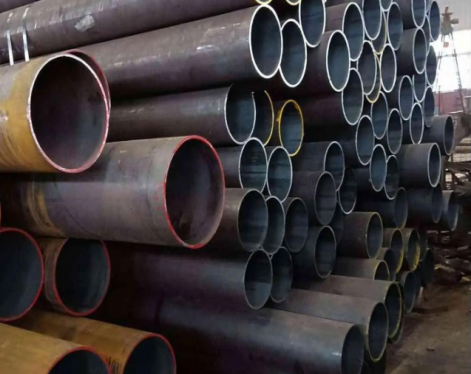The concept of hot expansion and hot rolling:
In the production process of seamless pipes, the two common methods are hot expansion and hot rolling. Hot expansion is to heat the steel billet to above 1200℃, and then use the pipe expander to process it into a hollow seamless steel pipe. This processing method can make the pipe have better heat resistance and better internal quality.
Hot rolling is to perform perforation, rolling and other processes on the finished steel billet after preheating, and finally form a seamless steel pipe.

The difference between hot expansion and hot rolling:
1. Different processes
Hot expansion: Hot expansion is to perforate the finished steel billet in a hot state to become a hollow seamless steel pipe. The specific process is to heat the seamless steel pipe billet or finished product in an electric furnace to above 1200 degrees, and then use an alloy core head to expand it to a certain outer diameter inside, so as to form it.
Hot rolling: Hot rolling is to roll the finished steel billet after preheating, and finally form a seamless steel pipe. The specific process is to use a punching machine to punch round steel into a tube billet, and then use a hot rolling machine to set the tube billet to a specified outer diameter, thereby forming a hot-rolled seamless steel pipe product.
2. Different scope of application
Hot rolling is suitable for low and medium pressure boiler tubes, high pressure boiler tubes, water cooler tubes, cylinders, etc.; while hot expansion is suitable for making large diameter seamless steel pipes;
3. Different properties
The surface of the hot-expanded seamless steel pipe is smooth and the inner and outer diameters are highly accurate, but the wall thickness is uneven; while the surface of the hot-rolled seamless steel pipe is relatively rough, the inner and outer diameters are relatively low, but the wall thickness is relatively uniform;
4. Different production efficiency
The production efficiency of hot expansion is relatively low, and each pipe needs to be processed several times; while the production efficiency of hot rolling is high, and batch production can be achieved.
Advantages and disadvantages of hot expansion and hot rolling:
1. Advantages and disadvantages of hot expansion seamless pipes
Advantages: high inner and outer diameter accuracy, smooth surface, good seamlessness;
Disadvantages: uneven wall thickness, low production efficiency, and high cost.
2. Advantages and disadvantages of hot-rolled seamless pipes
Advantages: high production efficiency, low cost, and wide applicability;
Disadvantages: low inner and outer diameter accuracy, rough surface, and difficult to control wall thickness.
In summary, hot expansion and hot rolling have their own advantages and disadvantages, and their scope of application is also different. In practical applications, the corresponding seamless steel pipe production process should be selected according to specific engineering requirements.
In the production process of seamless pipes, the two common methods are hot expansion and hot rolling. Hot expansion is to heat the steel billet to above 1200℃, and then use the pipe expander to process it into a hollow seamless steel pipe. This processing method can make the pipe have better heat resistance and better internal quality.
Hot rolling is to perform perforation, rolling and other processes on the finished steel billet after preheating, and finally form a seamless steel pipe.

The difference between hot expansion and hot rolling:
1. Different processes
Hot expansion: Hot expansion is to perforate the finished steel billet in a hot state to become a hollow seamless steel pipe. The specific process is to heat the seamless steel pipe billet or finished product in an electric furnace to above 1200 degrees, and then use an alloy core head to expand it to a certain outer diameter inside, so as to form it.
Hot rolling: Hot rolling is to roll the finished steel billet after preheating, and finally form a seamless steel pipe. The specific process is to use a punching machine to punch round steel into a tube billet, and then use a hot rolling machine to set the tube billet to a specified outer diameter, thereby forming a hot-rolled seamless steel pipe product.
2. Different scope of application
Hot rolling is suitable for low and medium pressure boiler tubes, high pressure boiler tubes, water cooler tubes, cylinders, etc.; while hot expansion is suitable for making large diameter seamless steel pipes;
3. Different properties
The surface of the hot-expanded seamless steel pipe is smooth and the inner and outer diameters are highly accurate, but the wall thickness is uneven; while the surface of the hot-rolled seamless steel pipe is relatively rough, the inner and outer diameters are relatively low, but the wall thickness is relatively uniform;
4. Different production efficiency
The production efficiency of hot expansion is relatively low, and each pipe needs to be processed several times; while the production efficiency of hot rolling is high, and batch production can be achieved.
Advantages and disadvantages of hot expansion and hot rolling:
1. Advantages and disadvantages of hot expansion seamless pipes
Advantages: high inner and outer diameter accuracy, smooth surface, good seamlessness;
Disadvantages: uneven wall thickness, low production efficiency, and high cost.
2. Advantages and disadvantages of hot-rolled seamless pipes
Advantages: high production efficiency, low cost, and wide applicability;
Disadvantages: low inner and outer diameter accuracy, rough surface, and difficult to control wall thickness.
In summary, hot expansion and hot rolling have their own advantages and disadvantages, and their scope of application is also different. In practical applications, the corresponding seamless steel pipe production process should be selected according to specific engineering requirements.









